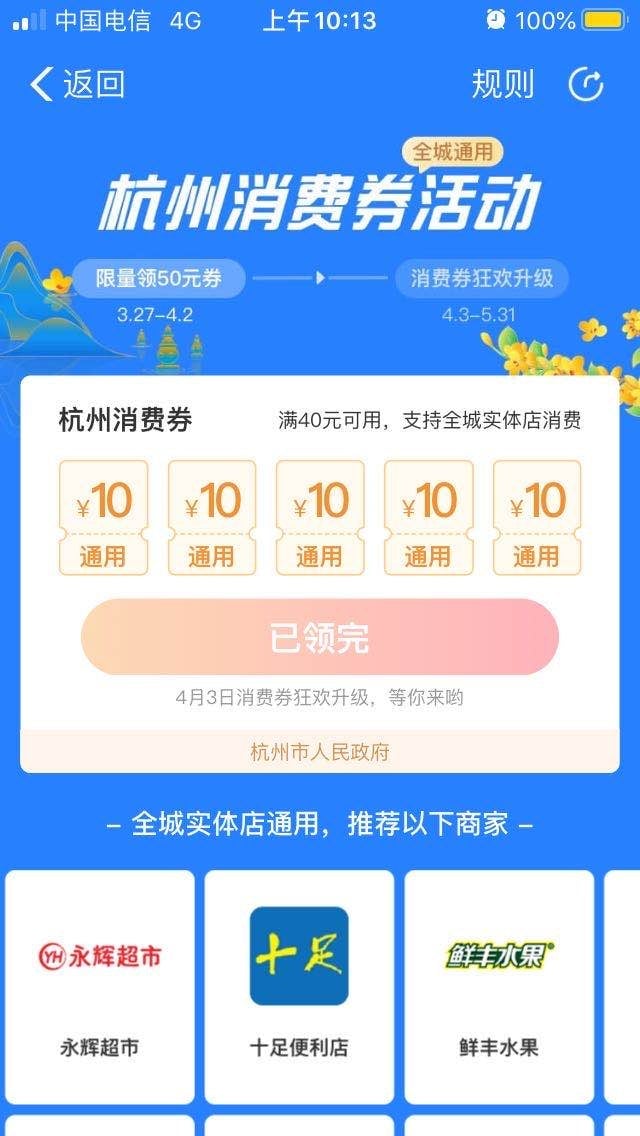China is using digital coupons to entice people to get shopping again
In January and February, as the coronavirus raged in China, the country recorded a shocking statistic—retail sales dropped 20.5% from a year ago, the first decline since records began. Now, as China feels increasingly confident that it has the pandemic under control, it’s gradually easing lockdowns and trying to get people to go out and spend money again.


In January and February, as the coronavirus raged in China, the country recorded a shocking statistic—retail sales dropped 20.5% from a year ago, the first decline since records began. Now, as China feels increasingly confident that it has the pandemic under control, it’s gradually easing lockdowns and trying to get people to go out and spend money again.
One of the key ways China is incentivizing people to do so is through the use of digital coupons, which are issued by some local governments and delivered to users via third-party platforms such as payment app Alipay and WeChat pay. Residents log in to the apps to redeem the coupons, which can be used for dining, shopping, and travel for a short within a short period of time.
Overall, more than 30 (link in Chinese) provinces and cities have rolled out these digital coupons. The city of Hangzhou in Zhejiang province plans to issue 1.68 billion yuan ($237 million) of such coupons, while Nanjing in Jiangsu province has distributed 318 million yuan in coupons. The individual discounts are often small—Hangzhou, for example, requires citizens to purchase at least 40 yuan worth of goods to spend a 10 yuan coupon. Each Hangzhou resident is also allowed to redeem only five such coupons a week. Shenzhen, meanwhile, requires people to redeem the vouchers through lucky draws (link in Chinese).

In addition to the dismal retail data—which is traditionally recorded for both January and February due to the distortion effects of the Lunar New Year—other metrics are pointing to a dire economic outlook. In February, China’s car sales plunged 79% from a year earlier, the biggest-ever monthly decline. A gauge of factory activity in March unexpectedly rebounded into positive territory after an abysmal performance the previous month, but officials warned that the data should not be seen as a sign of economic stabilization.
Overall, the data point to the world’s second-largest economy seeing its first contraction in quarterly GDP since 1989, when the country started releasing data comparable to today. A prominent adviser to the country’s central bank, meanwhile, has recommended that China do away with its long-standing tradition of setting a target for GDP growth this year—a political exercise that can shore up support for the Communist Party, but only when successful.
Other measures the Chinese government is taking to keep its pandemic-hit economy afloat include slashing its bank loan rate by the biggest level since 2015 to make it easier for companies to borrow. It will also allow local governments to sell more infrastructure bonds, increase the country’s fiscal deficit as a share of GDP, and issue special sovereign debt. The government is also encouraging local officials to dine out as much as possible to give a boost to the restaurant industry. In January and February, sales at restaurants contracted by 43.1% from a year ago.
Chinese officials have for years pinpointed consumption as the most important driver for economic growth, as the country continues to try to shift away from an export- and infrastructure-driven economy. Consumer spending made up about 58% of the country’s GDP growth in 2019, compared with 52% in 2011 (link in Chinese).
To stimulate consumption, some economies, such as Hong Kong and Macau, have opted to give citizens cash handouts, rather than coupons. However, Shan Weijian, a well-known Chinese private-equity investor, argued in an interview (link in Chinese) that cash subsidies have a limited effect on spurring consumption as not all the cash will be spent, while vouchers ensure that the money is allocated to retail sectors. “Consumption vouchers act like cardiotonic agents or engine lighters,” he said. “When the engine is started, the economy will return to normal and run on its own.”